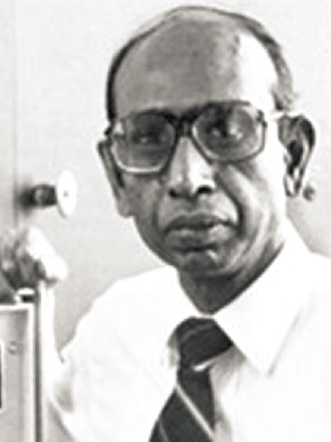
SUBBIAH RAMALINGAM
1935–2019
Elected in 1998
“For machining and tool-life theories, coating-design algorithms, and invention of novel automation sensors and steered-arc coating technology.”
SUBBIAH RAMALINGAM, emeritus professor of mechanical engineering at the University of Minnesota, died at age 83 in Minneapolis from complications of pneumonia on February 9, 2019. He had wide-ranging knowledge in the areas of mechanics of materials generally and specifically in metal cutting, tribology, and coatings, as well as design for manufacturing.
Ram was born June 15, 1935, in Udumalpet, in the South Indian state of Tamil Nadu. His father and elder brother were engineers and, with funds borrowed by his brother, he entered the new, highly competitive Indian Institute of Technology in Kharagpur. In addition to his studies he organized a film society (showing movies on a suspended bedsheet) and wrote poetry. From his student days, he pursued the Tamilian love of argument, often taking the opposite side to the prevailing view to keep the discussion lively.
Upon graduation (1956), he worked as a planning and forging engineer for Hindustan Motors, Ltd. in Uttapara, West Bengal. In 1960, encouraged by a visiting professor from America, he went to the University of Illinois at Urbana-Champaign, where he took every demanding course in the hard sciences he could find, and was promptly made an instructor. (He also began to support the professional studies of his two younger brothers.) He received an MS degree in 1961 and PhD in 1967,
both in mechanical engineering. In 1966, while still a student, he coauthored with his senior professor a small handbook on metals that remained in use for decades.
On completion of his PhD degree, he joined the UIUC faculty as an assistant professor and went on to enjoy a distinguished career as a researcher and teacher, spanning nearly 50 years. He authored or coauthored more than 100 articles and held six patents.
After stints at the State University of New York–Buffalo and Georgia Institute of Technology, he began teaching at the University of Minnesota in 1980, where he was also the first director of the Productivity Center. Asabbatical year inAustralia was jointly supported by Monash University (where he was a visiting professor), BHP’s Melbourne Research Laboratories, CSIRO’s Division of Tribophysics, and the Australian Ministry of Defence Materials Research Laboratories.
Ramalingam was a resourceful and inventive researcher, an outstanding engineer, and highly respected by his colleagues. He was also a brilliant lecturer who spoke without notes, clearly illuminating the essence of the topic he was developing that day. Liberal in both his praise and his censure, he would celebrate a student’s best efforts, and inspire an unprepared student to do better.
His major research and expertise included thin films for tribological applications, intelligent sensors, real-time sensing for manufacturing automation, solid lubricants, thin-film deposition processes and coating technology, machining and metal cutting theory, metal forming, closed loop control of machining, and manufacturing automation. He is regarded as one of the pioneers in the study of machining processes, sensors, and friction and wear (tribology). His collaboration with others in these fields dates back to when he was a UIUC graduate student working with some of the pioneers of metal cutting, such as Ken Trigger, B.T. Chao, and Branimir F. von Turkovich.
At the University of Minnesota he worked with Barney Klamecki on experimental measurements of friction in sheet metal forming. The two also created a very popular course,
ME 5229: Computer-Assisted Product Realization, an innovative (at the time), very difficult but inspiring hands-on class. Students would design and manufacture a plastic part going through all the stages from concept to final realization. Most of the course grade was based on the quality of the final product, and teams competed with each other. Extensive use was made of computer tools for stress analysis, mold flow analysis, CAD/CAM for tooling design, and manufacture.
In addition to his election to the NAE, he was a fellow of the American Society of Mechanical Engineers (ASME) and a member of the Materials Research Society, American Society of Metals, and North American Manufacturing Research Institute. And because he admired the journal of the Japan Society for Precision Engineering, he became the society’s first non-Japanese member, traveling several times to Japan and mastering conversational Japanese.
In 1980 he received ASME’s Blackall Award “For a distinguished contribution to the design or application of machine tools, gages, or dimensional measuring instruments.” And in 1988 he received the Frederick W. Taylor Research Medal from the Society of Manufacturing Engineers.
Ram was sought after as a consultant and gave numerous invited lectures at universities in the United States and around the world. He loved to travel, often combining laboratory visits with sightseeing—which was greatly enriched by his engineering perspective. He timed the famous echo beside the château in Chinon (three-fourths of a second). Looking at ancient cylinder seals in museums, he noted their relationship to repetitive processes in manufacturing. He saw early Jacquard looms in museums in France and Italy and commented on their descendants in Babbage’s computers and IBM’s punch cards. The open-air museums (Freilichtmuseen) in Germany, where he found examples of early machinery, craft implements, and manufacturing tools, both on display and in use, were a particular delight for him.
His colleagues describe him as a master in his field. He was recommended by many of them as a model for their own students to follow; from China, Japan, India, Australia, and
Europe, as well as in America, they sent their students to work under his guidance. Years later, many of these former students wrote to say that working with S. Ramalingam was one of the great experiences of their lives.
Ram saw the goodness in others. He was a remarkable engineer and professor whose contributions over the years left an indelible mark on our community.
He is survived by Vivian (née Safowitz), his wife of more than 50 years; his youngest brother S. Balakrishnan, sister Nirmala, and several nephews and nieces.






